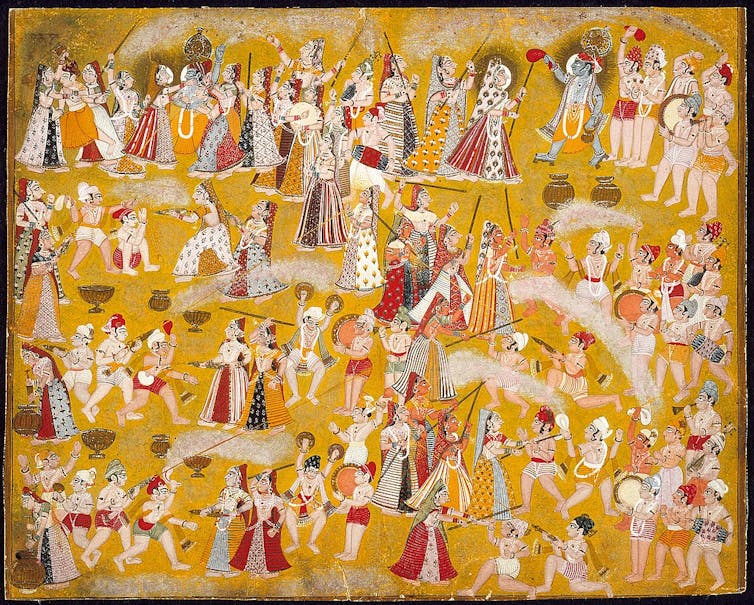Holi is one of the most vibrant and fun festivals in the Hindu calendar. It’s practiced across India (though mainly in the north), Nepal and throughout south Asian diasporic communities.
The date of Holi varies in accordance with the lunar calendar but the festival often takes place in February or March. In 2024, it’s celebrated on March 25.
People gather together to throw and smear gulal or colored powders over each other in a symbolic celebration of spring, the harvest, new life and the triumph of good over evil. As with many Hindu festivals, there is more than one narrative explaining its symbolism, but it is the visual splendor of this festival that explains its appeal.
My research focuses, in part, on the religious and material culture of Hinduism, especially in relation to its practice in contemporary culture. One of the most uplifting aspects of Holi is the way people from all walks of life come together. It is an expression of the dynamism of Hinduism and the power of fellowship.
An explosion of color
Holi conveys the exuberance and multisensory character of many Hindu festivals. The colored powders are typically red, yellow and green, representing the colors of spring but each also carrying more individual significance.
Red, which is popularly used in marriage celebrations, is the color of fertility. Yellow is regarded as an auspicious color. Green symbolizes new beginnings.
Traditionally, the colored powders used in Holi festivities were organically sourced from dried flowers and herbs. Today they are synthetic. Celebrants throw or smear handfuls on each other, or use water-filled balloons or pichkaris (water pistols) to disperse colored waster, adding to the carnivalesque feel of the event.
It is an immersive experience. Everyone comes together and merges in the magic of the crowd. Traditional hierarchies are suspended. Spontaneity and excitement take over. People talk about “playing” Holi in the powdered clouds of color.
As an ancient tradition with multiple regional variations, Holi is underpinned by two prevailing narratives. The first is the eternal divine love between Lord Krishna (the incarnation of the Hindu deity, Vishnu) and the goddess Radha.

LACMA|Wikimedia
The other tells of the demon king Hiranyakashipu’s attempt to force his subjects to worship him. When his son, Prahlad, persisted in worshipping Lord Vishnu instead, Hiranyakashipu instructed his sister, Holika, to kill Prahlad.
Holika, who was invulnerable to fire, made the boy sit on her lap, on a pyre. Onlookers were astonished to see, however, that Prahlad’s devotion to Lord Vishnu saved him while Holika burned to death.
The event of playing with colour, now synonymous with Holi, is actually part of a larger series of rituals. The first night of festival, known as Holika Dahan, involves lighting bonfires and throwing on food such as grains. As a re-enactment of the death of the mythical demoness Holika, this ritual marks the end of winter and the overthrow of evil.
The next day, Rangwali Holi, sees people venturing out on to the streets to exchange colour. In the final part of this festival, in the evening, after washing off the colours and donning clean clothes, people gather with family and friends to eat traditional dishes including gujiya (a North Indian sweet fried dumpling).
Like Diwali (the “festival of lights” as it is often known) and the Hindu new year, Holi is celebrated by the Hindu diaspora in the UK, the US, Fiji, Mauritius and beyond. Temple organizations host Holi in their venues. Unlike in India where festivities are public and widespread, diasporic celebrations are more regulated to specific spaces and times.
Parties for Holi are not uncommon. You can routinely find events organized each year on platforms such as Eventbrite where ticket sales often include the prior purchase of non-toxic powders.
Some of these events are targeted at south Asian communities. They include reenactments of plays, dance performances and further heritage elements.
Others capitalize on the spirit of revelry embodied by commercially driven color marathons. These have elicited claims of cultural appropriation for their largely secular tone.![]()
Rina Arya, Professor of Critical and Cultural Theory and Head of the School of the Arts, University of Hull. This article is republished from The Conversation under a Creative Commons license. Read the original article.










